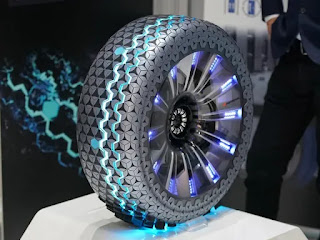Tires and Technology: How AI and IoT Are Revolutionizing the Industry 🛞🤖🌐🔧
When you think about cutting-edge automotive technology, tires might not be the first thing that comes to mind. But what if I told you that tires are evolving into some of the most advanced components of your vehicle? Thanks to Artificial Intelligence (AI) and the Internet of Things (IoT), tires are no longer just circular rubber attachments. They’re becoming high-tech tools designed to make your driving experience safer, more intelligent, and environmentally conscious.
Buckle up, because we’re diving into the revolutionary world of tire technology.
Smart Tires: The Engineering Marvel Beneath Your Vehicle
Say goodbye to manual tire pressure checks or guessing when your treads need attention. Smart tires equipped with IoT sensors are engineered to monitor key metrics like pressure, temperature, and tread depth, delivering real-time updates straight to your car’s system or your smartphone.
Imagine driving on the highway when your tire instantly alerts you to an issue before it escalates into a breakdown. Better yet, envision a tire that automatically adapts its grip based on rain, snow, or uneven terrain. This isn’t science fiction—it’s already happening with innovations like Michelin’s Vision Concept, a groundbreaking airless, 3D-printed tire that adjusts to changing road conditions with ease.
AI: Your Tire’s Predictive Genius
Artificial Intelligence acts as the brain behind the brawn of modern tires. By processing extensive data from tire sensors, AI systems can forecast maintenance needs with incredible accuracy—long before visible signs of wear and tear appear.
Think of it as having a personal tire technician in your vehicle. Forget the days of unexpected flats or guessing when replacements are due. Fleet operators already benefit from AI-driven insights, enabling proactive replacements and slashing downtime costs. For everyday drivers, it means constant reliability and the assurance that your tires are always road-ready.
Real-Time Adaptation: Tires That Respond in an Instant
What if your tires could detect a patch of black ice or a hidden pothole and instantly adjust to maintain control? Companies like Bridgestone are pushing boundaries with smart tires that use real-time data to fine-tune performance. These tires optimize grip, stabilize fuel efficiency, and respond dynamically to road hazards.
The beauty of this technology lies in its seamless operation. You won’t feel the adjustments—you’ll simply enjoy a smoother, safer ride while your tires do the thinking for you.
Eco-Innovations: Tires That Prioritize Sustainability
It’s not just about performance; AI and IoT are helping transform tires into eco-friendly allies. By maximizing tread life and ensuring precise inflation, intelligent tire systems reduce waste and lower carbon footprints. Why does this matter? Underinflated tires increase fuel consumption and CO2 emissions, costing both your wallet and the environment.
With sustainable solutions like smart inflation alerts and recyclable materials, these innovations are leading the charge toward greener roads.
Why High-Tech Tires Matter to You
Let’s face it: Tires aren’t the flashiest part of a car, but they’re becoming some of the smartest. Imagine driving a vehicle where your tires monitor themselves, keep you informed, and adapt to every twist and turn the road throws at you. These are no longer passive components—they’re active contributors to your safety, convenience, and even your environmental impact.
The Road Ahead: Intelligent Tires Leading the Way
AI and IoT are fundamentally transforming what tires can do. From real-time responsiveness to self-healing materials, these innovations are redefining the way we approach driving.
So, the next time you hit the road, remember this: Your tires aren’t just keeping your car rolling—they’re revolutionizing the journey. And with technology advancing at this pace, your tires might soon become the smartest part of your ride.
Ready to embrace the future of driving? Let’s roll!








Nice content
ReplyDeleteThanks for the info!
ReplyDeleteSuch a great read!
ReplyDeleteAmazing sharing
ReplyDeleteAmazing
ReplyDeleteTerbaik
ReplyDelete